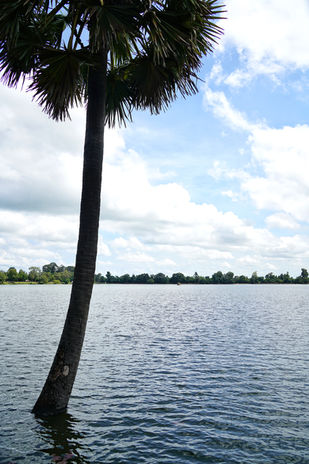
Srah Srang
Angkor, Cambodia
Reservoir of Kings
Srah Srang is an ancient baray, or reservoir, situated east of the walled city of Angkor Thom in Cambodia. Built in the 10th century during the rule of King Rajendravarman II, Srah Srang served as a water storage system to support the irrigation needs of Angkor. Measuring 700 by 350 meters wide, this manmade earthen basin was once able to hold over 50 million liters of water.
The banks of Srah Srang are surrounded by sandstone gopuras and ornately carved naga statues, which remain in excellent condition. Stone lingas once lined the eastern bank, representing the Hindu god Shiva. Though the lingas are now gone, their inscribed pedestals still stand. Bas-relief depictions of Hindu myths and Angkorian daily life adorn the walls of a temple-like structure on the northern end.
Today, Srah Srang no longer functions as a reservoir but retains a spirit of tranquility within Angkor Archaeological Park. The shallow waters reflect the sunset over the western gopuras, making it a favored spot for viewing the evening light over Angkor's monuments. Wandering the banks offers insight into the engineering ingenuity of Khmer hydraulic systems and the religious significance of Angkor's ancient waterways. Srah Srang provides a glimpse into how the people of Angkor managed water resources to support their civilization.
EXPLORE THE LOCATION
Use the interactive map to also discover nearby treasures.
QUICK FACTS

Location:
Srah Srang is located in the greater Angkor complex, 3 km east of Angkor Thom and just across from the Banteay Kdei complex.
Period:
Constructed in 10th century during rule of King Rajendravarman II
Purpose:
Served as a baray (reservoir) to store and manage water for irrigation of Angkor
Now:
No longer used as functional reservoir but remains a tranquil spot for admiring sunsets over Angkor ruins, or sitting on the steps for a quick reflection.
SNAPSHOTS OF THE TREASURE
















